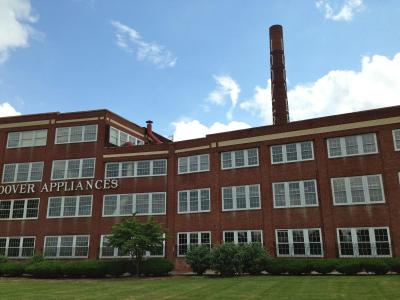By SAHIBA GILL
1.
Over the past forty years, Industrial Realty Group has acquired over a billion dollars of America’s obsolete industrial complexes, former military bases, and corporate campuses for retrofitting, conversion, and privatization. In 2007, the firm acquired the newly closed Hoover Plant, two blocks from my high school. Hoover once made the world’s most famous vacuums, and its old headquarters are still tremendous, a magnificent crowd of red brick and white windowpanes that run along a green lawn and announce themselves in white letters, “The Home of Hoover Fine Appliances.”
This is the town that Hoover built, and so it remains. Next to the factory stands a depression-era hall the company built as a community center that now houses the YMCA. Out the factory’s front door, across Main Street, is the rose window of St. Paul’s Church, which is in shouting distance of City Hall, Christian Community Church, and Chase Bank, which boast between them two pristine white spires. Runners pace easily down the brick sidewalks of Main Street, stepping everywhere over tree roots that stretch deep under the road and down the hills, beneath kitchen sinks and the football stadium, Home of the Hoover Vikings. Like any institutional campus, Main Street of North Canton, Ohio, is all landscaping, big money, and venerable walls. Now all the money is gone though, and the town is still chasing its youth.
2.
In 1908, Boss Hoover was looking to get out of the leather business because horse harnesses were going nowhere and the automobile was taking off. Hoover’s cousin-in-law was a janitor in North Canton, then New Berlin, and had newly patented a design for a rotating-brush portable vacuum cleaner. Hoover bought it. Within twenty years, Hoover vacuums were the first household name in floorcare, and they swept through America’s homes with industrial efficiency and speed. Soon the brand became a household name in Europe, too: pot, pan, Band-Aid, Hoover. The logo bore the Hoover name, exclaimed with a horizontal line sprinting through the H and out the circular seal – forward!
Yet in 1952, economist John Kenneth Galbraith characterized the prevailing attitude towards the American economy as a national bout of neurosis. The general concern over post-war American capitalism was that — like the bumblebee — it had achieved flight against the laws of nature that predicted its impossibility. Liberals warned that business interests were not worthy of the public’s civic trust; conservatives maintained that markets were unstable with a tendency to depression. Ultimately, as predicted, the bees’ wings slowed. During the 1980s, Hoover cut a third of its unionized workforce, opened an assembly plant in Mexico, and underwent a series of mergers and acquisitions. The Chicago Pacific Corporation bought out the Hoover Family in 1986, then sold it to Maytag in 1994. When Whirlpool bought Maytag in 2007, Hong Kong-based Techtronic Industries acquired the Hoover Company and transferred Hoover vacuum production to El Paso, closer to Juarez.
Bees have been falling out of the sky for thirty years, of course, but within a single town there is something about the last bee – no more bees – that leads one to hang on to small victories. When they shuttered the plant in 2007, TTI terminated a total of 750 positions. But when I drove by the factory this June, five years after its close, I noticed that Industrial Realty Group, known as IRG, had posted a small billboard on the Hoover lawn. It is a scoreboard of sorts, although there is no mention of who the other team is or who is winning. But the game remains in play. “The Hoover District,” it reads, “800+ Jobs and Counting!”
 3.
3.
People everywhere tune in to watch this game. Surrounded by the rusted, below-average income and declining growth of Stark County, with its corporate headquarters along I-77 and 1970s-era cornfields-turned-malls—courtesy of health care and finance money—Hoover’s oaked walk ways are viewed by cable news networks and east coast papers as national synecdoche, bellweathering election results and next quarter’s unemployment rate. I watch because the part—Main Street, North Canton—seems so different from the whole, the unsentimental asphalt desert of suburbia through which I drove north each morning from Canton where I lived, to Hoover, where I went to school.
Until I went to high school there were certain items for sale in parts of Ohio that I could never comprehend and that I commonly saw purchased at our local big box craft store: wood plaques saying “Home is Where the Heart Is,” rusted tin stars, needlepoint pillows, silk leaf autumn inspirations wreathes. In Canton, among adults that I knew, there were no signs of such kitschy consumption. But in North Canton, this mass-produced sentimentality accumulated privately in living rooms and kitchens. More surprisingly, it dominated Main Street: Victorian lamp-posts, auto-patinated copper water fountains, filigreed park benches and brick carpeted pedestrian crossings. Much of the ornamentation was created after a 1994 rezoning of Main Street during which Maytag privatized 171 acres of Hoover’s property. The factory town was waning. North Canton’s response it was to embalm itself in manufactured nostalgia, as if Main Street’s winsome pretenses could paper over death.
4.
When I was a kid, the sleeping porch was a fixture of a bedtime story; it was where a boy took refuge from a storm; he watched the rain pour around him as he drifted off to sleep. I had forgotten the sleeping porches by the time I found real ones in high school on Pershing Street, which began at the percussive high school bleachers and crept long and close behind the empty Hoover lot behind the main factory. After cross-country practice I used to sneak back out past the stadium and walk slowly down that road. The houses there hung jauntily along low telephone lines, grey metal gingerbread houses with playhouse windowpanes, all prefab industrial design for factory town living; houses that were – once – an extension of the plant itself. I was never one for hiding in the high school bathroom, but I needed moments away from home that were not in hallway throngs of gossip or in a stretching circle on the track. The sleeping porches gain came to symbolize asylum: front porches on yellow houses—and blue, and white, and grey ones—nested with crushed pillows and enveloped in spun mesh.
This road was old. Invisible to turgid Main Street, it pulsed with the agonal hum of the Hoover Factory, its gears and pistons and brushes and motors. I imagined that if I could just touch any one of the screens on these factory homes I would feel the metal push back under my fingers, spare and necessary, entirely real. I wanted to sleep under the canopy of the house and watch the walls of grass and pines turn shades of blue as night fell, awaking to dew trapped by the porch screen and held suspended against the morning light. But the houses were not mine, and I had no choice but to keep running.
5.
In 2011, North Canton made the final turn of the dial that returned Hoover’s company town back to its pre-2007 winning job score. Suarez Corporation Industries, a locally based company with manufacturing facilities in China, hired 250 workers to operate a plant in North Canton to manufacture its EDENPure energy-efficient space heaters. The triumphal return of jobs from China to America—and to green manufacturing jobs—traded in Main Street’s feeble clutchings at its past heroics. “Suarez Manufacturing Industries: The Home of EDENPure” now reads in the same copperplate letters as the Hoover Factory once did, but where Hoover led in in floor care market share, EDENPure space heater is a cheap “As Seen on TV” item that Consumer Reports ranks as the second-worst space heater on the market. At the time of its close, the Hoover Factory had paid $13 to $17 hourly; the Suarez Corporation pays only Ohio minimum wage for its assembly line work.
IRG has half of its business in Ohio; it has repurposed the former “rubber capital of the world,” thirty minutes north in Akron, and an old Ford plant near Cleveland. In North Canton, it partnered with the city to create Maple Street Commerce, which now collects rents on old Hoover space from a honed tubing factory, electric systems factory, wholesale warehouse, Medicare consulting, and IT support offices. Hoover’s corporate offices are now the Stark State College Corporate Service and Continuing Education campus. A Hoover warehouse that shuttered in 2005 reopened five years later as a 3,788-seat megachurch on a road near the interstate called Freedom Avenue. Finally, this summer Maple Street Commerce released the architect renderings of the Hoover District, “a prosperous mix of manufacturing, retail, restaurants, office and loft style living, essentially creating an avant-garde lifestyle.”
The renderings of the new Hoover District have superimposed a row of bright awnings over the giant first-floor windows of the old brick Hoover building, shading imaginary Main Street shops selling coffee, donuts, shoes, apparel, and toys. As the hesitation of that word “essentially” in the District’s self-promotion admits, industry is mostly gone. Post-industrial America, as it has been called, can admit knowledge only of past flights and falls, nothing of the future. Documentary photographs of now-bankrupt Detroit show the remains of the once-great city infinitely deranged, de-arranged: turned-down chairs, torn down wallpaper files with their loose-leaf contents emptied on the floor of deserted rooms. As if to stave off physical decline, Hoover’s Main Street has anxiously made itself flat and ineffably dense, weighted down by its canned provisions of the neatly picturesque. Despite losses to China and Mexico, Main Street insists upon remaining a small world, after all.
 6.
6.
As of this summer, the lot next to the Hoover Factory between Pershing and Main Streets has been — just temporarily — abandoned. A row of former parking space markers read “HOOVER LOT: PARKING AT YOUR OWN RISK.” The sleeping porches are just across the lot. Their magic was in the gentle contact they permitted both with nature and the wild dying machines of the Hoover Factory. Here too, in this lot, the factory is decomposing mildly: its forms remain intact but it has allowed nature to press through its grids of mortar and metal. Underneath my feet, fine wet gravel has settled in warps and wefts knotted with green sowthistle and dandelion. In the farthest corner of the property, ivy consumes a chain link fence, and I clamber on and hang over it to see over the tall deep grass over which Queen Lace Anne flies and through which I can barely make out the mascot-painted football stadium and, in the foreground, a metal cylinder and a cottage-sized factory outpost. All that verdant field is inaccessible “Property of the Hoover Factory,” as the sign on the fence warns, but it is enough to lean against the wire fabric and watch the factory change. I wish that this spot would stick around until next summer, when I come home again. It is a prettier place than Main Street to watch things live and die.
Sahiba Gill is Assistant Editor at The Common and a Global Academic Fellow at NYU Abu Dhabi.



